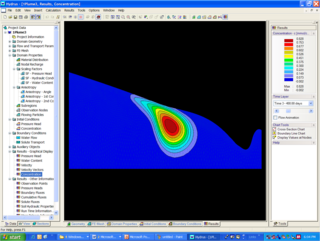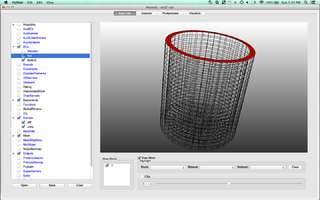
An aquifer is an underground layer of water-bearing permeable rock, rock fractures or unconsolidated materials. Groundwater can be extracted using a water well. The study of water flow in aquifers and the characterization of aquifers is called hydrogeology. Related terms include aquitard, which is a bed of low permeability along an aquifer, and aquiclude, which is a solid, impermeable area underlying or overlying an aquifer. If the impermeable area overlies the aquifer, pressure could cause it to become a confined aquifer.

The water table is the upper surface of the zone of saturation. The zone of saturation is where the pores and fractures of the ground are saturated with water.

Hydrogeology is the area of geology that deals with the distribution and movement of groundwater in the soil and rocks of the Earth's crust. The terms groundwater hydrology, geohydrology, and hydrogeology are often used interchangeably.
Darcy's law is an equation that describes the flow of a fluid through a porous medium. The law was formulated by Henry Darcy based on results of experiments on the flow of water through beds of sand, forming the basis of hydrogeology, a branch of earth sciences.
Used in hydrogeology, the groundwater flow equation is the mathematical relationship which is used to describe the flow of groundwater through an aquifer. The transient flow of groundwater is described by a form of the diffusion equation, similar to that used in heat transfer to describe the flow of heat in a solid. The steady-state flow of groundwater is described by a form of the Laplace equation, which is a form of potential flow and has analogs in numerous fields.
Groundwater models are computer models of groundwater flow systems, and are used by hydrogeologists. Groundwater models are used to simulate and predict aquifer conditions.

Hydrus is a suite of Windows-based modeling software that can be used for analysis of water flow, heat and solute transport in variably saturated porous media. HYDRUS suite of software is supported by an interactive graphics-based interface for data-preprocessing, discretization of the soil profile, and graphic presentation of the results. While HYDRUS-1D simulates water flow, solute and heat transport in one-dimension, and is a public domain software, HYDRUS 2D/3D extends the simulation capabilities to the second and third dimensions, and is distributed commercially.
MIKE SHE is an integrated hydrological modelling system for building and simulating surface water flow and groundwater flow. MIKE SHE can simulate the entire land phase of the hydrologic cycle and allows components to be used independently and customized to local needs. MIKE SHE emerged from Système Hydrologique Européen (SHE) as developed and extensively applied since 1977 onwards by a consortium of three European organizations: the Institute of Hydrology, SOGREAH (France) and DHI (Denmark). Since then, DHI has continuously invested resources into research and development of MIKE SHE. MIKE SHE can be used for the analysis, planning and management of a wide range of water resources and environmental problems related to surface water and groundwater, especially surface-water impact from groundwater withdrawal, conjunctive use of groundwater and surface water, wetland management and restoration, river basin management and planning, impact studies for changes in land use and climate.

A hydrologic model is a simplification of a real-world system that aids in understanding, predicting, and managing water resources. Both the flow and quality of water are commonly studied using hydrologic models.
FEHM is a groundwater model that has been developed in the Earth and Environmental Sciences Division at Los Alamos National Laboratory over the past 30 years. The executable is available free at the FEHM Website. The capabilities of the code have expanded over the years to include multiphase flow of heat and mass with air, water, and CO2, methane hydrate, plus multi-component reactive chemistry and both thermal and mechanical stress. Applications of this code include simulations of: flow and transport in basin scale groundwater systems , migration of environmental isotopes in the vadose zone, geologic carbon sequestration, oil shale extraction, geothermal energy, migration of both nuclear and chemical contaminants, methane hydrate formation, seafloor hydrothermal circulation, and formation of karst. The simulator has been used to generate results for more than 100 peer reviewed publications which can be found at FEHM Publications.
SVFLUX is a finite element seepage analysis program developed by SoilVision Systems Ltd.. The software is designed to analyze both saturated and unsaturated flow through the ground through the solving of Richard's equation. The program is used in the fields of civil engineering and hydrology in order to analyze seepage and groundwater regional flow. The software is used for the calculation of flow rates, pore-water pressures, and pumping rates associated with regional groundwater flow. The software can be coupled with CHEMFLUX in order to calculate diffusion, advection, and decay rates or with SVHEAT in order to calculate thermal gradients and freeze/thaw fronts.

SHETRAN is a hydrological modelling system for water flow, solute and sediment transport in river catchments. SHETRAN is a physically based, distributed model (PBDM) that can simulate the entire land phase of the hydrologic cycle including surface water flow and groundwater flow. The plan area of the catchment in SHETRAN is usually in the range of one to a few thousand square kilometres and the horizontal depth of the subsurface is usually less than 100m.
Reactive transport modeling in porous media refers to the creation of computer models integrating chemical reaction with transport of fluids through the Earth's crust. Such models predict the distribution in space and time of the chemical reactions that occur along a flowpath. Reactive transport modeling in general can refer to many other processes, including reactive flow of chemicals through tanks, reactors, or membranes; particles and species in the atmosphere; gases exiting a smokestack; and migrating magma.

MOOSE is an object-oriented C++ finite element framework for the development of tightly coupled multiphysics solvers from Idaho National Laboratory. MOOSE makes use of the PETSc non-linear solver package and libmesh to provide the finite element discretization.

The finite water-content vadose zone flux method represents a one-dimensional alternative to the numerical solution of Richards' equation for simulating the movement of water in unsaturated soils. The finite water-content method is an ordinary differential equation alternative to the Richards partial differential equation. The Richards equation is difficult to approximate in general because it does not have a closed-form analytical solution except in a few cases. The finite water-content method, is perhaps the first generic replacement for the numerical solution of the Richards' equation. The finite water-content solution has several advantages over the Richards equation solution. First, as an ordinary differential equation it is explicit, guaranteed to converge and computationally inexpensive to solve. Second, using a finite volume solution methodology it is guaranteed to conserve mass. The finite water content method readily simulates sharp wetting fronts, something that the Richards solution struggles with. The main limiting assumption required to use the finite water-content method is that the soil be homogeneous in layers.
The Marine Unsaturated Model is a two-dimensional finite element model capable of simulating the migration of water and solutes in saturated-unsaturated porous media while accounting for the impact of solute concentration on water density and viscosity, as saltwater is heaving and more viscous than freshwater. The detailed formulation of the MARUN model is found in and. The model was used to investigate seepage flow in trenches and dams, the migration of brine following evaporation and, submarine groundwater discharge, and beach hydrodynamics to explain the persistence of some of the Exxon Valdez oil in Alaska beaches.

In geology, numerical modeling is a widely applied technique to tackle complex geological problems by computational simulation of geological scenarios.

Noam Weisbrod is a Professor of Hydrology in the Department of Environmental Hydrology and Microbiology at the Zuckerberg Institute for Water Research (ZIWR), which is part of the Jacob Blaustein Institutes for Desert Research (BIDR) at Ben-Gurion University of the Negev (BGU). Weisbrod served as director of ZIWR from 2015 to 2018. In 2018 he became director of BIDR.


















